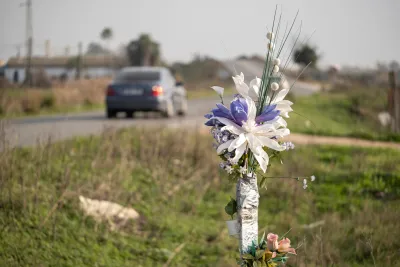Funding from the Bipartisan Infrastructure Law aimed at making streets safer is being awarded through a competitive grant program, but it’s not going to the communities that need it most, an investigation shows.

Two years into the Bipartisan Infrastructure Law’s rollout, a USA TODAY investigation has found most of the $5 billion Safe Streets and Roads for all program has so far gone to more affluent counties with lower fatality rates rather than to the disadvantaged communities it was promised to benefit. The reason? “[B]ecause the grants are structured to reward communities that already have the resources to pursue the funding,” writes USA TODAY reporter Austin Fast.
Whereas cities like Detroit, which received about $50 million from the program to improve its streets, have an 18-member grant writing staff, many small cities like Gallup, New Mexico — home to Native communities often left out of such programs but with disproportionately high traffic fatality rates — have no dedicated grant writer and therefore can’t compete with the larger cities or don’t ask for money at all. “[Gallup is] exactly the type of disadvantaged place the Biden administration promised would benefit from a massive influx of federal money for safer streets,” Fast reports.
In addition to lack of resources to complete the application, the USA TODAY investigation found additional barriers blocking the neediest communities from winning the grants, including poor communication of availability and eligibility for the funds, lack of direct outreach to disadvantaged and rural places with highest fatality rates, and lack of clarity around weighting of fatality rate when grading applications (since data shows nearly all of the money has gone to counties the U.S. Department of Transportation acknowledges have low fatality rates).
Competitive grants do have their place in rebuilding American infrastructure, Kristin Smith told USA TODAY. Smith researches public finance with Montana-based nonprofit Headwaters Economics. “But when it comes to funding that is meant to save people’s lives, that’s designed to meet people’s basic needs, a competitive grant, in my opinion, isn’t the right tool,” Smith said. “It’s regressive. You have to have resources to access it.”
FULL STORY: Safe Streets grants are supposed to save lives. Why are they missing so many deadly roads?

National Parks Layoffs Will Cause Communities to Lose Billions
Thousands of essential park workers were laid off this week, just before the busy spring break season.

Retro-silient?: America’s First “Eco-burb,” The Woodlands Turns 50
A master-planned community north of Houston offers lessons on green infrastructure and resilient design, but falls short of its founder’s lofty affordability and walkability goals.

Delivering for America Plan Will Downgrade Mail Service in at Least 49.5 Percent of Zip Codes
Republican and Democrat lawmakers criticize the plan for its disproportionate negative impact on rural communities.

Test News Post 1
This is a summary

Test News Headline 46
Test for the image on the front page.

Balancing Bombs and Butterflies: How the National Guard Protects a Rare Species
The National Guard at Fort Indiantown Gap uses GIS technology and land management strategies to balance military training with conservation efforts, ensuring the survival of the rare eastern regal fritillary butterfly.
Urban Design for Planners 1: Software Tools
This six-course series explores essential urban design concepts using open source software and equips planners with the tools they need to participate fully in the urban design process.
Planning for Universal Design
Learn the tools for implementing Universal Design in planning regulations.
EMC Planning Group, Inc.
Planetizen
Planetizen
Mpact (formerly Rail~Volution)
Great Falls Development Authority, Inc.
HUDs Office of Policy Development and Research
NYU Wagner Graduate School of Public Service





























